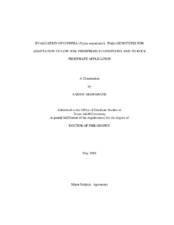| dc.description.abstract | Cowpea (Vigna ungiculata L. Walp) is a major food and fodder legume in poor
countries, particularly Sub-Saharan Africa countries. It is generally produced in sandy,
acid soils, deficient in phosphorus (P) which severely limits its production. Because
processed phosphate fertilizers are expensive and poorly available to farmers, rock
phosphate is viewed as a cheap alternative phosphate source. The present study
evaluated 696 U.S Core Collection and IITA cowpea accessions for adaptation to low
soil P environments and for response to rock phosphate application. Subsequently,
organic acid exudation by selected cowpea genotypes as a mechanism for P acquisition
from Fe-oxide and Ca bound P was investigated.
A low P soil from Nacogdoches pine forest was used to grow plants. There were
two P treatments: 0 and 300 mg P/kg of soil as Tahoua (Niger) rock phosphate. At
harvest, plant height, shoot and root dry weights were determined and total biomass and
shoot-to-root ratios were computed. Shoot P contents of 100 selected accessions were measured. Sixteen accessions reflecting the wide array of responses observed were
selected for the organic acid study. Plants were grown in a growth chamber
hydroponically with no P and +P nutrient solutions for 3 weeks. Organic acids were
collected in a CaCl2-KCl solution. The nature and quantity of the collected organic acids
was determined.
Cowpea accessions were significantly different in their ability to adapt to Pdeficiency
stress and to acquire P from rock phosphate. The parameters most effective in
separating the accessions were shoot mass and total biomass. This data will be
potentially useful in the selection of cowpea germplasm for (1) adaptation to West
African soils of low P fertility, and (2) ability to utilize P from poorly soluble rock
phosphate. The predominant organic acid exuded by cowpea roots was a tricarboxylic
acid not yet identified. There was surprisingly more exudation of this acid under +P than
under –P conditions. Exudation was more highly correlated to roots than to shoots. | en |


